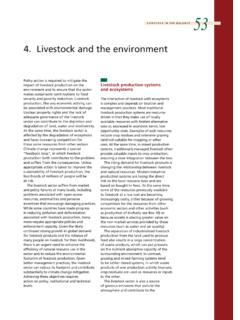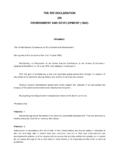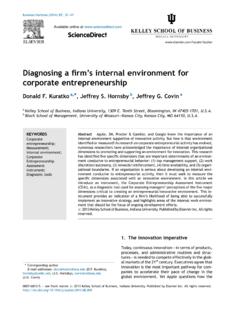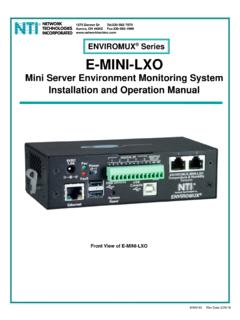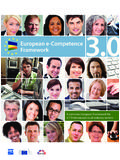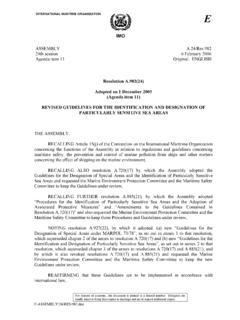Transcription of Walking the Nexus Talk: Assessing the Water-Energy-Food ...
1 Walking the Nexus Talk: Assessing the Water-Energy-Food Nexusin the Context of the Sustainable Energy for All InitiativeISSN 2226-606258E N V I R O N M E N T C L I M A T E C H A N G E [ E N E R G Y ] M O N I T O R I N G A N D A S S E S S M E N T e n v i r o n m e n t A N D N A T U R A L R E S O U R C E S M A N A G E M E N T W O R K I N G P A P E Ral on nt gy, ces ure d on-is rrry xus ord ene ce Copies of FAO publications can be requested fromE-mail:Fax:Web site:Sales and Marketing GroupOffice of Knowledge Exchange, Research and ExtensionFood and Agriculture Organization of the United NationsViale delle Terme di Caracalla - 00153 Rome, 06 57053360 image in this page Other images:elaborated from L Encyclop die Diderot et D Alembert Cover photo credits (left to right):Selectra; Silversands Ethanol; FAO; Remko Tanis (retrieved on flick on 11 July 2014 and released under a Common Creative licence for non-commercial purposes); The Sahara Forest Project; The Sahara Forest Project.
2 Canary Islands Institute of FlamminiManas PuriLucie Pluschke Olivier Dubois58E N V I R O N M E N T C L I M A T E C H A N G E E N E R G Y M O N I T O R I N G A N D A S S E S S M E N T e n v i r o n m e n t A N D N A T U R A L R E S O U R C E S M A N A G E M E N T W O R K I N G P A P E R[] Walking the Nexus Talk: Assessing the Water-Energy-Food Nexusin the Context of the Sustainable Energy for All InitiativeClimate, Energy and Tenure Division (NRC) Food and Agriculture Organization of the United NationsJuly 2014]E N E R G Y[The designations employed and the presentation of material in this information product do not imply the expression of any opinion whatsoever on the part of the Food and Agriculture Organization of the United Nations (FAO) concerning the legal or development status of any country, territory, city or area or of its authorities, or concerning the delimitation of its frontiers or boundaries.
3 The mention of specific companies or products of manufacturers, whether or not these have been patented, does not imply that these have been endorsed or recommended by FAO in preference to others of a similar nature that are not views expressed in this information product are those of the author(s) and do not necessarily reflect the views or policies of 978-92-5-108487-8 (print)E-ISBN 978-92-5-108488-5 (PDF) FAO, 2014 FAO encourages the use, reproduction and dissemination of material in this information product. Except where otherwise indicated, material may be copied, downloaded and printed for private study, research and teaching purposes, or for use in non-commercial products or services, provided that appropriate acknowledgement of FAO as the source and copyright holder is given and that FAO s endorsement of users views, products or services is not implied in any requests for translation and adaptation rights, and for resale and other commercial use rights should be made via or addressed to information products are available on the FAO website ( )ns)ns)ns) and can be purchased through O N T E N T S579111317171819244648526365667277849098 102107111115125127 AcknowledgementsEXECUTIVE SUMMARY1.
4 INTRODUCTION2. WHAT IS THE Water-Energy-Food Nexus ?3. CONCEPTUALIZING THE Water-Energy-Food NEXUS4. Nexus The components of the Nexus Operational development goals to structure the components of the Nexus Stakeholder Quantitative context Application of specific Nexus tools to quantify impacts and draw Assessing the performance of specific An example of Nexus rapid appraisal in Comparison of interventions5. CASE Case study Solar steam Case study Ethanol Case study Electricity subsidies for farmers in Case study Hydropower dams in the Mekong river Case study The Sahara Forest Case study On-grid wind energy for water desalination for Case study Bioenergy from degraded soil6. SUMMARY AND WAY FORWARDR eferences ANNEX 1 Selected indicators for Nexus linkagesANNEX 2 Benchmarks for country typologies ANNEX 3 Collation of specific Nexus tools to quantify impacts and draw scenariosA C K N O W L E D G E M E N T SThis work was prepared under the overall supervision of Olivier Dubois, Senior Natural Resources Officer (Climate, Energy and Tenure Division) and benefited from inputs from several FAO colleagues, including Erika Felix (Climate, Energy and Tenure Division), Jean-Marc Faures and Jippe Hoogeveen (Land and Water Division).
5 We would also like to thank Sharon Darcy for her assistance in the finalization of this report is the main output of project GCP/GLO/496/OPF funded thanks to the generous support of the OPEC Fund for International Development (OFID). Walking the Nexus Talk: Assessing the Water-Energy-Food Nexus in the Context of the Sustainable Energy for All InitiativeAlessandro Flammini, Manas Puri, Lucie Pluschke, Olivier Dubois147 pages, 23 tables, 28 figuresEnvironment and Natural Resources Working Paper No. 58 FAO, Rome, 2014 Keywords: Nexus , assessment, energy, water, food, land, integrated assessment, approach, SE4 All, sustainability, policy-making7C H A P T E RE X E C U T I V E S U M M A RYThis report proposes a way to carry out a Water-Energy-Food Nexus assessment approach in order to: a) understand the interactions between water, energy and food systems in a given context, and b) evaluate the performance of a technical or policy intervention in this given context.
6 The ultimate goal of the Water-Energy-Food (WEF) Nexus assessment is to inform Nexus -related responses in terms of strategies, policy measures, planning and institutional set-up or a) of the assessment focuses on the context analysis, providing information on the Nexus context status: The current state and pressures on natural and human resources systems; Expected demands, trends and drivers on resources systems; Interactions between water, energy and food systems; Different sectoral goals, policies and strategies in regard to water, energy and food; this includes an analysis of the degree of coordination and coherence of policies, as well as the extent of regulation of uses; Planned investments, acquisitions, reforms and large-scale infrastructure; Key stakeholders, decision-makers and user the context analysis, a number of problem-specific tools are suggested for a more in- depth, quantitative analysis of the impacts of different resource uses and for the development of scenarios and strategic b) of the assessment looks specifically at the performance of technical and policy interventions in terms of resource use efficiency and productivity.
7 Importantly, the performance of interventions should be also assessed versus the Nexus context status. A set of basic indicators is proposed, out of which the final selection should take place in consultation with stakeholders. It is also possible to compare different interventions, based on how efficiently they make use of water, energy, food/ land, employment and financial stakeholders should be actively engaged in the assessment process to build consensus on strategic issues across sectors and scales and to decide on how to respond to these different elements of the Nexus assessment are illustrated in the following figure. 8]E N E R G Y[The proposed WEF Nexus assessment approach helps Walking the talk regarding Nexus promotion. It is innovative in many ways: it provides a stepwise process to address policy-making and intervention in a Nexus manner; the indicators it proposes have been selected on the basis of available international datasets in case one wishes to carry out a Nexus rapid appraisal, as the second best option to generating context specific information; it combines quantitative and qualitative assessment methods; last but not least, it considers it is essential to link intervention assessment to context status as a key condition to assess the sustainability and appropriateness of interventions.
8 The approach shows how to do this in practice. Given its innovative character, the proposed Nexus assessment approach should be considered work in progress, to be improved as lessons from its implementation will be drawn. Y LJ / Y LJ / d d LJ // LJ d LJ /// / LJ /s Z d F i g u r e E . 1 The components of the Nexus assessment H A P T E RDue to global transformational trends, such as population growth, economic development and climate change, energy, water, land and human resources are increasingly under pressure to support societal development and to maintain necessary services.
9 Decision-makers need improved tools in order to be better informed about trade-offs and synergies between different development and management choices, and to help them identify options on how to sustainably manage report proposes a way to carry out a Water-Energy-Food Nexus assessment that can be used by stakeholders concerned with the development and management of resources, and in line with the global sustainability agenda. The WEF Nexus assessment can be used to assess the Nexus interlinkages at any scale, although data are usually available at country level. It can highlight synergies between sector interventions, so-called win-win solutions, helping stakeholders to develop insights into different options, which might not be apparent at first glance. The objectives of such an assessment are to:1. provide an overview of the current Nexus status of the context in terms of natural resources and their uses to sustain society, through the identification and quantification of key Nexus interlinkages;2.
10 Apply specific tools to derive this information that is not readily available (for which indicators are not already available);3. review and suggest how specific Nexus interventions can be assessed and compare the performance of specific interventions on the basis of the context status against WEF sustainability goals; and4. interpret the results of the Nexus assessment, contextualize possible interventions and appropriate response ultimate goal of the WEF Nexus assessment is to inform Nexus -related responses in terms of strategies, policy measures, planning and institutional set-up or N T R O D U C T I O N10]E N E R G Y[Adequate stakeholder engagement at all stages of the Nexus assessment is a key condition to ensure high quality assessment and response. The report focuses on the different elements that compose the Nexus Assessment , as a stepwise approach to define Nexus issues and assess the impacts of different intervention options.











